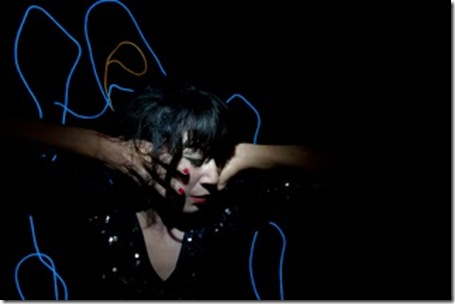Trieste: An evocative atmosphere still in search of a story
Photo: Minelly Kamemura.
Trieste, Marie Brassard’s haunting performance, which premiered at Montreal’s Festival TransAmériques on February 25th and is inspired by the Italian city of the same name, is a performance that happens around a script. There are many beautiful aspects to the play: Brassard is a born story-teller – her voice is smooth and deep and she uses sound and images expertly to transport the audience to a city which seems more out of this world than of it. She sits on a chair under dim lighting and presents her travelogue of Trieste, the Italian city on the Adriatic Sea known for attracting artists such as James Joyce, Sigmund Freud, and Dante. Although not much to look at (by European standards, at least), the city is saturated with their spirits and leaves a lasting impression on those that visit. Brassard is an expert at creating a dream-like atmosphere and her skills truly shine in Trieste. It’s easy to get caught up in the seductive pull of her piece and forget that, while technically well done, the story is tstill a work in progress.
Brassard intertwines her experiences in the city with her ruminations on solitude, life, death, destiny, and history – all packed into one existential, if sometimes confusing, modern fable. The Bora, a cold, strong wind which blows through Trieste and is rumored to have the ability to drive some mad, permeates the piece, evoked by the visuals and sound. Yet, despite the foreboding bora and the spirits that surround the artist and audience, the chaos created isn’t malevolent, ugly or vengeful. The ghosts here are hopeful, thoughtful, at times even playful incarnations of what was, is and what can only only exist in our imaginations. The text, although beautiful and dreamlike, is secondary to the atmosphere, which doesn’t so much convey a story as a mood. The script has a tendency to meander somewhat aimlessly and the connection between themes is sometimes lost.
The visual and auditory elements, however, play up Brassard’s story and infuse the text with importance. Her decent to the Grotta Gigante in search for the Timavo river is a testament to the simplicity and beauty of her work. Brassard “descends” with nothing but the help of a flashlight and music and her journey is instantaneously transformed from a tourist trip to a mythical realm of philosophy and history, steeped in the intense feelings the place clearly evokes in the artist. The music follows her narrative, blending seamlessly and, indeed, telling the story much better than her words.
Brassard works in the world of dreams. She creates a platform situated somewhere just beyond your imagination; a place at once gray and teeming with colour and sound from which she tells her stories. Her use of light and sound is so precise that it overcomes the story. Although it starts out strong and the technical aspects mask the deficiencies in text, Trieste does start to drag after the halfway mark. Much like the bora that is so central to it, Brassard’s Trieste is beautifully evocative and filled with strength of feeling and conviction, but that very strength is what makes the script lose its focus. It’s too turbulent and tries to do too much. The elements need to be brought into balance with each other as, currently, message is sacrificed for ambience.
Trieste
Coproduction Festival TransAmériques and Usine C
Presented in association with Usine C
Creative residency: Experimental Media and Performing Arts Center
Written, directed and performed by: Marie Brassard
Music and sound composed and performed by: Jonathan Parant and Alexandre St-Onge
Set design: Simon Guilbault
Video and 16 mm film: Karl Lemieux
Editing: Charles André Coderre
Lighting design: Mikko Hynninen
Sound design: Frédéric Auger
Technical and production manager: Vincent de Repentigny
